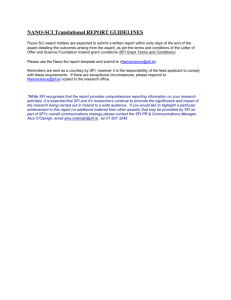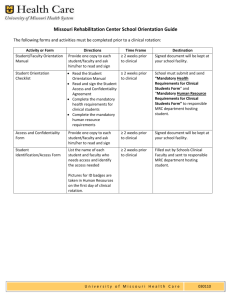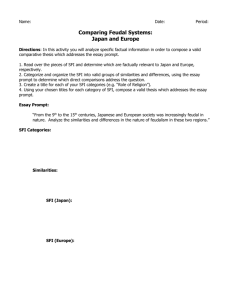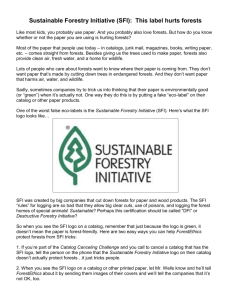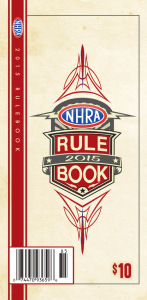Top SPORTSMAN
advertisement
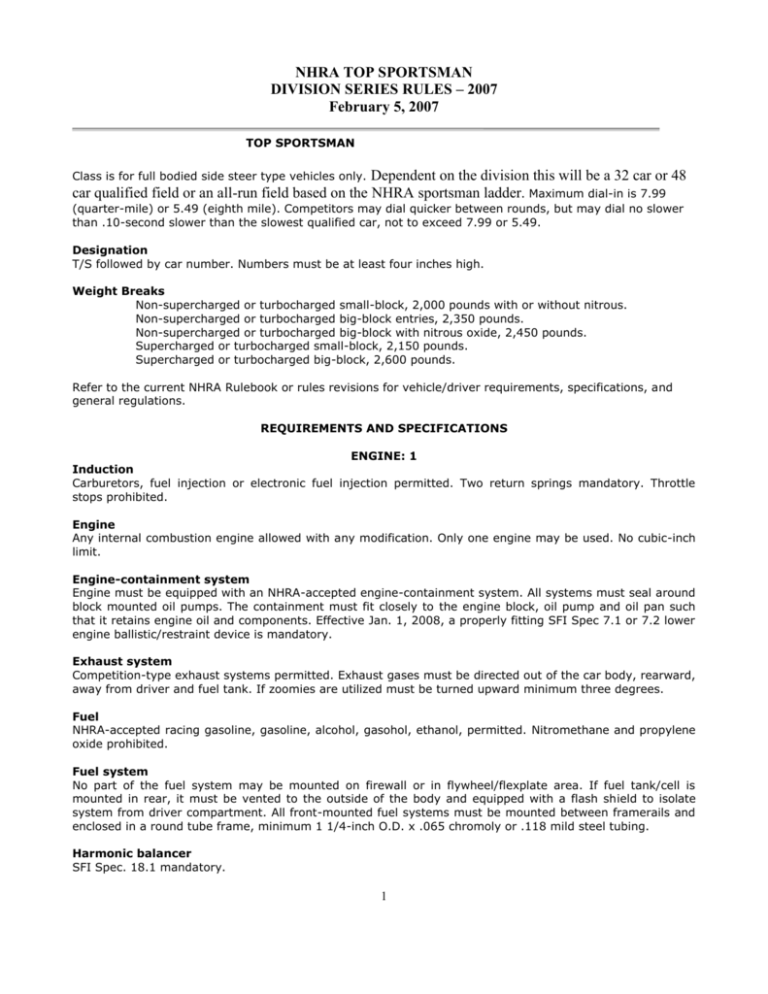
NHRA TOP SPORTSMAN DIVISION SERIES RULES – 2007 February 5, 2007 TOP SPORTSMAN Class is for full bodied side steer type vehicles only. Dependent on the division this will be a 32 car or 48 car qualified field or an all-run field based on the NHRA sportsman ladder. Maximum dial-in is 7.99 (quarter-mile) or 5.49 (eighth mile). Competitors may dial quicker between rounds, but may dial no slower than .10-second slower than the slowest qualified car, not to exceed 7.99 or 5.49. Designation T/S followed by car number. Numbers must be at least four inches high. Weight Breaks Non-supercharged or turbocharged small-block, 2,000 pounds with or without nitrous. Non-supercharged or turbocharged big-block entries, 2,350 pounds. Non-supercharged or turbocharged big-block with nitrous oxide, 2,450 pounds. Supercharged or turbocharged small-block, 2,150 pounds. Supercharged or turbocharged big-block, 2,600 pounds. Refer to the current NHRA Rulebook or rules revisions for vehicle/driver requirements, specifications, and general regulations. REQUIREMENTS AND SPECIFICATIONS ENGINE: 1 Induction Carburetors, fuel injection or electronic fuel injection permitted. Two return springs mandatory. Throttle stops prohibited. Engine Any internal combustion engine allowed with any modification. Only one engine may be used. No cubic-inch limit. Engine-containment system Engine must be equipped with an NHRA-accepted engine-containment system. All systems must seal around block mounted oil pumps. The containment must fit closely to the engine block, oil pump and oil pan such that it retains engine oil and components. Effective Jan. 1, 2008, a properly fitting SFI Spec 7.1 or 7.2 lower engine ballistic/restraint device is mandatory. Exhaust system Competition-type exhaust systems permitted. Exhaust gases must be directed out of the car body, rearward, away from driver and fuel tank. If zoomies are utilized must be turned upward minimum three degrees. Fuel NHRA-accepted racing gasoline, gasoline, alcohol, gasohol, ethanol, permitted. Nitromethane and propylene oxide prohibited. Fuel system No part of the fuel system may be mounted on firewall or in flywheel/flexplate area. If fuel tank/cell is mounted in rear, it must be vented to the outside of the body and equipped with a flash shield to isolate system from driver compartment. All front-mounted fuel systems must be mounted between framerails and enclosed in a round tube frame, minimum 1 1/4-inch O.D. x .065 chromoly or .118 mild steel tubing. Harmonic balancer SFI Spec. 18.1 mandatory. 1 Liquid overflow Catch-can mandatory for coolant overflow; one-pint (16-ounce) minimum capacity. Nitrous Oxide Permitted on non-supercharged or non-turbocharged entries. Prohibited on supercharged and turbocharged entries. Oil lines All flexible pressurized oil lines must pass a minimum 300 psi pressure test and be clearly labeled as passing the testing process. Starter All entries must be self-starting with an onboard starter and battery. Supercharger All supercharged entries may utilize a 14-71 (or smaller) standard or hi-helix supercharger. All cars using 12-71 or 14-71 superchargers must have a SFI 14.2 or 14.3 restraint with approved bag from same manufacturer. All other superchargers require a SFI 14.1, 14.2 or 14.3 restraint. Belt guards shielding both fuel and oil lines are mandatory. The blower restraint straps and fuel lines must be installed such that when the restraint straps are fully extended no load is placed on any of the fuel lines. Aluminum studs (supercharger-to-manifold) mandatory. Throttle Stop The use of throttle stops, stutter boxes, etc., to control down track engine rpm is prohibited. Throttle stops are defined as being mechanical, electronic or pneumatic. Throttle stop may be present on vehicle but must be disconnected from all controls. Turbocharger The use of single or dual turbochargers is permitted. This combination will compete at the supercharged weight minimums. Valve Covers Cast or fabricated metal valve covers, using all attachment bolt holes, mandatory on supercharged, methanol burning cars. Vent Tube/Breathers Mandatory for all supercharged engines. Two one-inch diameter connections. All breathers must be positive locking. DRIVELINE: 2 Clutch, Flywheel, Flywheel Shield Flywheel and clutch meeting SFI Spec 1.1, 1.2, or 1.5 mandatory. Flywheel shield meeting SFI 6.1, 6.2, or 6.3 mandatory on clutch equipped cars. Engine combination determines the appropriate specifications. See the appropriate SFI specification or NHRA General Regulations for the motor plate and bolting requirements. Driveline Each end of driveshaft must have round 360-degree driveshaft loops within 6 inches of U-joints. Flexplate Automatic transmission flexplate meeting SFI Spec 29.1 mandatory. Flexplate Shield Flexplate shield meeting SFI Spec 30.1 mandatory. A SFI 6.1 bellhousing is permitted on torque converter assisted planetary transmissions. Rear End 2 Aftermarket axles and axle-retention devices mandatory. Welded spider gears prohibited. Wheel studs must be 5/8-inch minimum. Aftermarket full-floating or live axle assembly mandatory on any vehicle that runs 6.50 and quicker or 210 mph and faster. Independent rear suspension prohibited. Transmission Any transmission may be used, however, vehicle must employ positive system to disengage from final drive. All automatic transmissions must have a neutral safety start switch and reverse lockout device. All entries with pressurized transmissions must have interior sheet metal tunnel isolating the driver’s compartment from the transmission. All pressurized units must utilize flexible hoses pressure tested to 300 psi and be clearly labeled as passing the testing process or solid steel lines and AN fittings to connect with accessory coolers. A minimum 1/8-inch pipe connection using high-pressure line vent to overflow tank (minimum 1pint capacity) is mandatory. Transmission Shield A one piece transmission shield meeting SFI Spec 4.1 is mandatory on all automatic and planetary transmissions. BRAKES & SUSPENSION: 3 Brakes Four-wheel brakes mandatory with dual master cylinder mounted above framerails on all entries. Steel brake lines mandatory. Wheelie Bars: Permitted. Wheels must be non-metallic. FRAME: 4 Ballast Permitted, 250 pounds maximum, 100 pounds maximum removable. Chassis All cars must use a full frame that meets SFI Spec. 25.1E or SFI Spec. 25.2 that run 7.499 and quicker. Cars running 7.50 and slower must meet applicable SFI Specification (25.1E, 25.2, 25.4, or 25.5) for body/chassis design. Must have current NHRA serialized sticker affixed to the cage before participation. Ground clearance Minimum three inches required from the front of the car to 12 inches behind axle centerline, 2 inches for remainder of car except oil pan and exhaust headers. Parachute Required. Cars running in excess of 200 mph must use dual parachutes with two separate shroud line mounting points using sleeved 1/2-inch bolts. Safety pins must be red-flagged and removed before burnout. Wheelbase Minimum 90 inches. One-inch variation from left to right. WHEELS & TIRES: 5 Tires Must be automotive type, designed for racing. Wheels Each car in competition must be equipped with automotive-type wheels, designed for racing. SFI Spec 15.1 rear wheels with beadlocks mandatory on any vehicle that runs 6.50 and quicker or 210 mph and faster. INTERIOR: 6 Upholstery Optional. Window Net Required. Must meet SFI Spec. 27.1. 3 BODY: 7 Airfoils A positive locking device must be used to prevent accidental movement. Side-mounted canard-type units are permitted. No part of airfoils may be within six inches of tires. Body Must be full-bodied vehicle (trucks, vans, wagons permitted) with two functional doors. Front overhang limited to 45 inches from center of front spindle unless stock OEM is longer. Firewall Required. Each car in competition must be equipped with minimum .024-inch steel or .032-inch aluminum firewall. See Protective Clothing requirements below. Floor Minimum .024-inch steel welded in on driver's side from firewall to rear cross member. Remainder .032 aluminum or .024-inch steel. Hood Scoop Limited to 13 inches on all cars. Measured from flat portion of hood to top of opening. Windshield, Windows Required, no window tint beyond factory specification permitted. The side windows on all entries that utilize nitrous oxide or are supercharged must have a minimum 4-inch-diameter opening adjacent to the driver. ELECTRICAL/CONTROL: 8 Battery All batteries must be securely mounted. See General Regulations 8:1. Delay Box/Devices: Delay boxes permitted. Two-step accepted for starting-line use. Down track throttle stops, electronic ignition interrupters (stutter boxes), or use of pneumatics are prohibited. Pneumatic starting line enhancers are prohibited for use on naturally-aspirated, fuel-injected, or nitrous-assisted entries. If units are on such a entry it must be clearly verified that units are disconnected or otherwise nonfunctional. Turning off the delay function leading to the device is not a satisfactory method. Supercharged and turbocharged entries may only utilize the units in place of two-step functions. One delay box/device is permitted; it may be attached to the transbrake, and/or shift timer only. The wire to the transbrake (or line-loc) may contain a splice that activates the two-step/launch-control device in the ignition system. All wiring associated with the delay device, ignition system, automatic shifter, tachometer, data recorder, and fuel-injection system must be fully visible, labeled, and traceable. Delay devices and associated components (such as transbrakes, automatic shifters, data recorders, tachometers, fuel-injection system, etc.) must be utilized in an unaltered manner consistent with the manufacturer’s installation and instruction books unless otherwise approved. Any ignition system tachometer function or any other RPM function is prohibited from interaction with the delay device on any car that uses a pneumatic starting line enhancer. Ignition Aftermarket electronic ignition boxes must be used unaltered from factory specifications. Timed ignitioninterruption devices (stutter boxes) prohibited. Starting-line and/or “high-side” rev limiters permitted. Twosteps, rev limiters, or any other rpm-limiting devices, legal unto themselves but altered or installed so as to function as a downtrack rpm controller, prohibited. The wire to the transbrake (or line-loc) may contain a splice that activates the two-step/launch-control device in the ignition system. For supercharged and turbocharged applications also see the Delay Box/Devices paragraph above. The use of any programmable multi-point rev limiter and/or a rate of acceleration rpm limiter, either by themselves (i.e. MSD 7561) or integrated into the ignition system (i.e. MSD 7531) are prohibited. Master cutoff Master electrical cutoff switch required. Must be external and labeled "push-off." See General Regulations 8:4. 4 Taillight One functional taillight mandatory. Flashing, blinking, or strobe lights prohibited. SUPPORT GROUP: 9 Data recorders Permitted. Data recorders may be used to record functions of a vehicle so long as they do not activate any function on the vehicle. Data recorder may not be activated by the throttle, clutch, brake, etc. Must be activated by a separate switch. Data may be reviewed (printout, replay, etc.) only after the run. Fire-extinguisher system Five-pound fire-extinguisher system mandatory. Minimum one nozzle on driver's side in front of feet, one nozzle in front of engine. Safety pins must be red-flagged and removed prior to burn-out. Tow vehicle Three- or four-wheeled, Quadrunner/ATV-type tow vehicle permitted. Full-size tow vehicle prohibited. DRIVER: 10 Credentials NHRA competition license and NHRA Top Sportsman number with appropriate license code 3B or 4B and NHRA membership required. Driver restraint system Three-inch driver restraint system meeting SFI Spec. 16.1 mandatory. Restraint system must be updated at two-year intervals from date of manufacture. Roll-cage padding Mandatory. Must meet SFI Spec. 45.1. Helmet Helmet meeting Snell 98, 2000, 2005 or SFI Spec. 31.1A, 31.2A, 41.1A, 41.2A mandatory. Neck Collar Neck collar meeting SFI Spec 3.3 mandatory. A helmet and neck restraint device can be used with, or without, a neck collar. Modification of the device is prohibited. Effective 1/1/2008, a head and neck restraint device/system is mandatory for any vehicle running 200 mph or faster. The device/system must meet SFI Spec 38.1 and must display a valid SFI label. The head and neck restraint device/system, when connected, must conform to the manufacturer's mounting instructions, and it must be configured, maintained, and used in accordance with the manufacturer's instructions. Protective Clothing Supercharged or turbocharged cars (alcohol or gasoline): Jacket and pants or suit meeting SFI 3.2A/15, gloves meeting 3.3/5, and boots or shoes meeting 3.3/5 mandatory. Full-bodied cars without .024-inch minimum steel firewall with nitrous oxide(alcohol or gasoline): Jacket and pants or suit meeting SFI 3.2A/15, gloves meeting 3.3/5, and boots or shoes meeting SFI Spec 3.3/5 mandatory. All other cars (alcohol or gasoline): Jacket and pants or suit meeting SFI 3.2A/5, gloves meeting 3.3/1, and boots or shoes meeting SFI 3.3/5 mandatory. RACE PROCEDURES: Qualifying Dependent on the division this will be a 32-car or 48-car qualified field or an all-run field based on the NHRA sportsman ladder. Maximum dial-in is 7.99 (quarter-mile) or 5.49 (eighth mile). Competitors may dial quicker between rounds, but may dial no slower than .10-second slower than the slowest qualified car, not to exceed 7.99 or 5.49. Points 5 A driver's best five finishes of the first eight NHRA Top Sportsman races attended will count toward a division championship. At the time a driver enters a divisional event for the first time of the season, it is required that said driver declare which NHRA division (Southeast Division, North Central Division, or South Central Division) is to be his or her home division. That division will become his or her home division for the season. Up to two "out-of-division" races may be counted. Once a driver has competed for points at the maximum number of eight Top Sportsman events, the driver may compete at additional events but will not receive additional NHRA points. To be eligible for official NHRA Top Sportsman points and subsequent postseason awards, a contestant must participate at a minimum of three races within his or her home division. Points are awarded at all NHRA Top Sportsman events as follows: Points are awarded at all NHRA Top Dragster events as follows: Actual 1st Rd. 2nd Rd. 3rd Rd. 4th Rd. Field size loser loser loser loser 4 or fewer 33 5 to 8 32 43 9 to 16 31 42 53 17 to 32 30 41 52 63 33 to 48 30 40 51 62 Additional points are awarded for qualifying positions as follows: 1st 8 2nd 7 3rd 6 4th 5 5th & 6th 4 7th & 8th 3 9th through 12th 2 13th through 16th 1 6 5th Rd. loser 73 R/U Win 64 64 64 74 84 85 85 85 95 105

